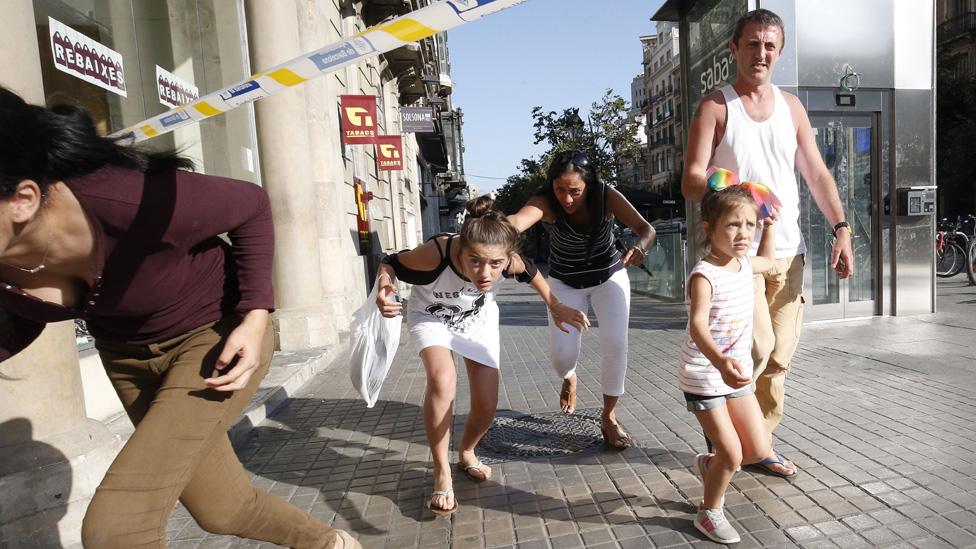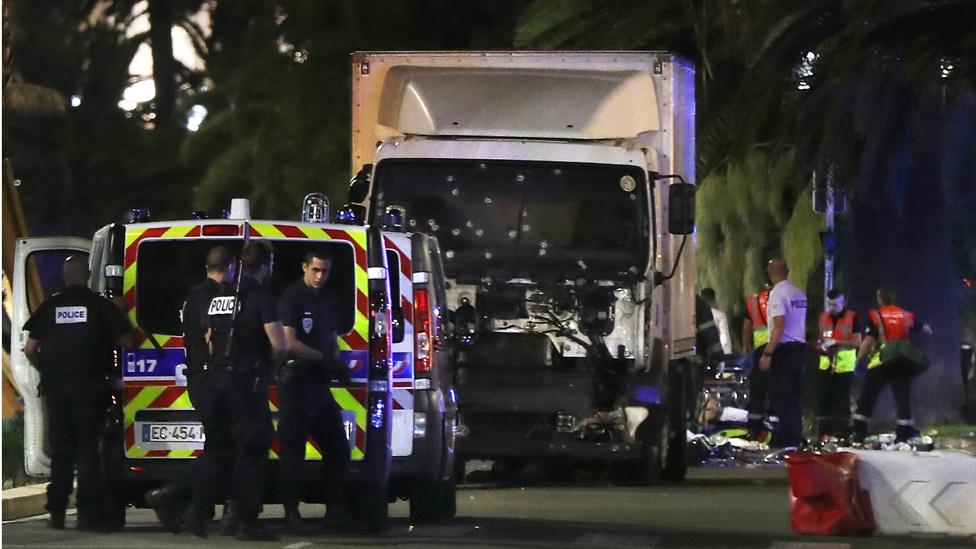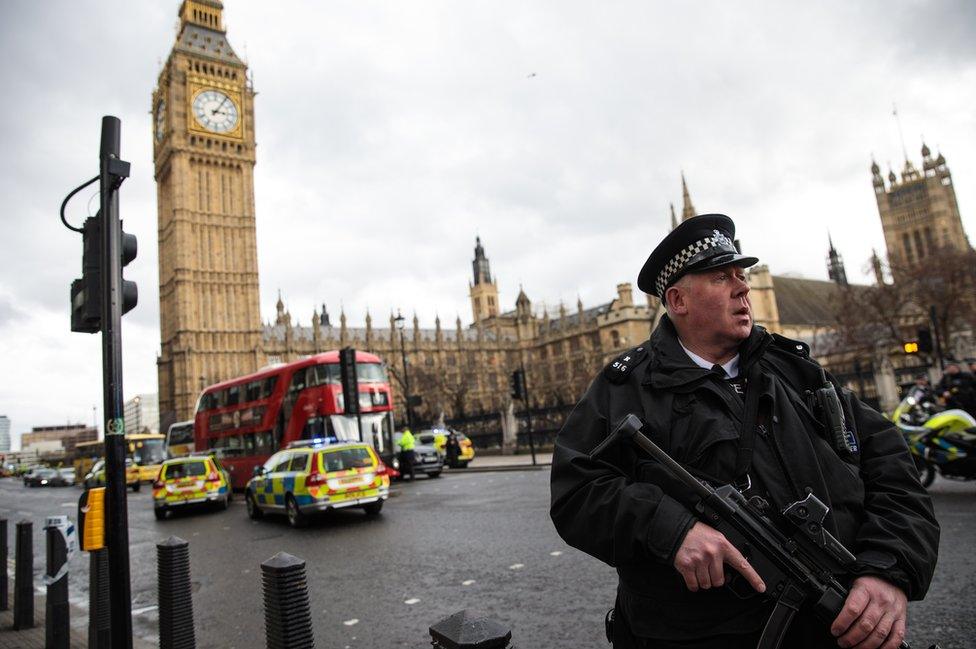Who was behind the jihadist attacks on Europe and North America?
- Published

A series of attacks in Europe over the summer months has raised the number of people killed in the West by jihadists during the past three years to more than 420, writes Dr Lorenzo Vidino.
The deaths of 16 people in Barcelona and Cambrils earlier this month highlighted the continued threat posed by Islamist militants.
The summer months have also seen new attacks in Belgium, France, Austria, external, Germany and the UK, as well as the first in Finland and one in the US.
Although the vast majority of Islamist attacks are elsewhere in the world, an unprecedented number have taken place in Europe and North America since the declaration of a "caliphate" by the so-called Islamic State, in June 2014.
The first look at the data behind the attacks, external - everything from the age of the perpetrators, to immigration status - offers an insight into those responsible and how they might be tackled.

Where the attacks were

Flowers and a flag left near the Orlando nightclub where an Islamist gunman killed 49 people in June 2016
Regardless of country, most attacks were in large towns and cities - including Barcelona, London, Manchester, Paris, Nice, Berlin, Brussels, Stockholm and Orlando.
A few attacks hit iconic targets, such as the Champs-Elysees and the Louvre museum in Paris, Westminster in London and Las Ramblas in Barcelona.
Many others targeted crowded spaces such as busy pedestrian areas, entertainment venues or transport hubs.
But some terrorist attacks have hit more unusual places, including an office Christmas party and a service at a church.

How the attacks were identified
We looked at attacks motivated by jihadist ideology, that involved deliberate acts of violence against other people and were intended to intimidate or convey a message to a larger group. Other organisations use different definitions.
Researchers used open-source material and interviews with officials
It is possible that some attacks did not come to our attention, or that full details are not available
The research covers the US, Canada and the 28 member states of the EU, plus Norway and Switzerland
Attacks motivated by other ideologies - such as the murder of Jo Cox - are not included in this study

The dead and injured
In total, the 63 attacks caused 424 deaths and left almost 1,800 people injured.
The perpetrators are not included in these figures.
The Paris attack of November 2015 was the deadliest, with 130 people killed, including 90 at the Bataclan theatre.
France also saw the Nice lorry attack, which left 86 people dead.

14 July 2016: A lorry ploughed into a crowd in the French Riviera town of Nice
There were many other attacks that left many people dead and others injured.
In Orlando, 49 people were killed in an attack on a gay nightclub
Bombings at Brussels airport and at a metro station left 32 people dead
14 people were killed at a Christmas party in San Bernardino, California
12 people died when a lorry was driven into a crowded Christmas market in Berlin
12 people died when the Paris offices of Charlie Hebdo were attacked in January 2015
Five people were killed in the Westminster attack in April
The Manchester Arena bombing in May led to 22 deaths
The London Bridge attack in June left eight people dead
The attacks in Barcelona and Cambrils left 16 people dead
In total, these 11 attacks were responsible for 386 deaths.
However, most of the attacks did not cause casualties, with the exclusion of the perpetrators.

Who the attackers were
Although the number of young people being radicalised has caused concern, the average age of the attackers - 27.5 - is not unusually young.
The two youngest were 15 - an unnamed boy who attacked a Jewish teacher with a machete in Marseille, and Safia S, a girl who stabbed a police officer at a Hannover train station.
Of the five who were under the age of 18 at the time, four were in Germany.
The vast majority of the attackers were in their 20s, with about one in four attackers above the age of 30 and six aged 40 or older.
The oldest suspect, Mohamed H Khalid, was 54 when he was accused of stabbing to death an elderly couple in the Austrian city of Linz, external.
In the UK, Khalid Masood, was 52 when he drove into pedestrians on Westminster Bridge and stabbed to death a police officer at the Houses of Parliament.
Despite women becoming increasingly active in jihadist networks, only two out of 85 individual perpetrators were female.
Fewer than one in five perpetrators was a convert to Islam, with a significantly higher percentage in North America than in Europe.
However, the converts were significantly more likely to have a criminal background and to have served time in prison.
Overall, half of the attackers had a prior criminal background.

Immigration status
The relationship between terrorism and migration is a complex one and has been at the centre of extremely polarising debates, particularly during the European migrant crisis.
However, the number of attackers who were illegally in a country or who arrived as refugees is small.
Two-thirds were citizens of the country they attacked, with others either legal residents, or legal visitors from neighbouring countries.
However, individuals who were in the West illegally also carried out deadly attacks.

November 2015: Tributes left in Paris following attacks that left 130 people dead
At least two of those involved in the November 2015 Paris attacks are thought to have posed as refugees to enter Europe through Greece.
Three other individuals were refugees or asylum seekers at the time of attack, while seven were in the country illegally or awaiting deportation.
The latter group includes Uzbek national Rakhmat Akilov, who killed four people with a hijacked lorry in Stockholm in April 2017, and Tunisian citizen Anis Amri, who also used a lorry to commit his attack at the Berlin Christmas market.

Wreckage from an attack on a Berlin Christmas market, December 2016
There is also one case of "terrorist tourism", involving Egyptian citizen Abdullah Hamamy, who lived in the United Arab Emirates and attacked soldiers at the Louvre in February 2017.

Links to IS
Two of the four most lethal attacks - those in Paris in November 2015 and in Brussels in 2016 - are believed to be well orchestrated multiple attacks directed by IS, external.

22 March 2016: A security guard helps a wounded woman after the attack on the Brussels metro system
They were also executed in part by former foreign fighters.
However, the two other most deadly attacks - those in Orlando in June 2016 and in Nice in July 2016 - were carried out independently by individuals without operational connection to a jihadist group.
These episodes demonstrate that terrorist sympathisers who never travelled to conflict areas and who act independently can be as dangerous as a team of highly trained militants.
Overall, links between attackers and jihadist groups operating overseas are not always easy to determine.
Of the attacks that have hit the West since June 2014, fewer than one in 10 was carried out under direct orders from the leadership of IS.
In some cases it can be difficult to tell, for example IS said it was behind both the Las Ramblas and Cambrils attacks, but it did not provide any evidence.
Nevertheless, the influence of IS can be clearly seen.
During or before the attack, six out of 10 perpetrators pledged allegiance to a jihadist group, almost always IS - which frequently claims responsibility.

Learning the lessons
Unsurprisingly, given the frequency of attacks and the number of deaths and injuries, jihadist terrorism has come to the fore of political debates in the West and receives widespread news coverage.
The threat is not expected to wane in the near future, with policymakers, counter-terrorism officials and the public all being asked to take action.

22 March 2017: Westminster Bridge following a terror attack
There are huge implications for domestic and foreign policy throughout Western countries.
It is hoped that knowing more about the attacks and the people who carried them out will help us all have a more informed debate about what action is needed.

About this piece
This analysis piece was commissioned by the BBC from an expert working for an outside organisation.
Dr Lorenzo Vidino, external is the director of the Program on Extremism at the George Washington University, external and of the Program on Radicalisation and International Terrorism at the Italian Institute for International Political Studies, external (ISPI) in Milan
This research is part of a report by ISPI, George Washington's Program on Extremism and the International Centre for Counter-terrorism, external in The Hague, conducted by Dr Vidino, along with Dr Francesco Marone, external and Eva Entenmann, external
Full report: Fear Thy Neighbor. Radicalization and Jihadist Attacks in the West, external
An earlier version of this piece was published on 14 June 2017. This version provides updated figures, based on the attacks that have subsequently taken place.

Edited by Duncan Walker
